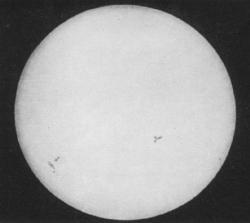 Monday, April 2 – Today in 1889, the Harvard Observatory’s 13″ refractor arrived at Mt. Wilson. Just one month later, it went into astronomical service at Lick Observatory, located at Mt. Hamilton. It was here that the largest telescopes in the world resided from 1908 to 1948. The 60″ for the first decade, followed by the 100″. This latter mirror is still the largest solid piece ever cast in plate glass and weighed 4.5 tons. Would you believe it’s just 13 inches thick?
Monday, April 2 – Today in 1889, the Harvard Observatory’s 13″ refractor arrived at Mt. Wilson. Just one month later, it went into astronomical service at Lick Observatory, located at Mt. Hamilton. It was here that the largest telescopes in the world resided from 1908 to 1948. The 60″ for the first decade, followed by the 100″. This latter mirror is still the largest solid piece ever cast in plate glass and weighed 4.5 tons. Would you believe it’s just 13 inches thick?
Continue reading “What’s Up this Week: April 2 – April 8, 2007”
What’s Up this Week: March 25 – April 1, 2007
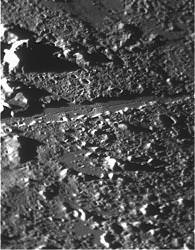 Monday, March 26 – Much like our crater from last night, tonight we we’ll explore the lunar surface for another surface scar caused by a glancing blow. Head to the north near the terminator as the incredible Alpine Valley now comes into view.
Monday, March 26 – Much like our crater from last night, tonight we we’ll explore the lunar surface for another surface scar caused by a glancing blow. Head to the north near the terminator as the incredible Alpine Valley now comes into view.
Continue reading “What’s Up this Week: March 25 – April 1, 2007”
What’s Up this Week: January 29 – February 4, 2007
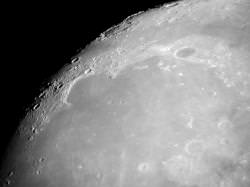 Monday, January 29 – Tonight we will return again to the lunar surface to have a look through binoculars or telescopes at another tremendous impact region.
Monday, January 29 – Tonight we will return again to the lunar surface to have a look through binoculars or telescopes at another tremendous impact region.
Continue reading “What’s Up this Week: January 29 – February 4, 2007”
What’s Up this Week: January 22 – January 28, 2007
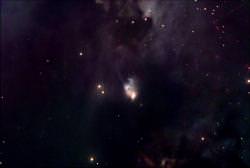 Monday, January 22 – Be out early tonight to catch the slender crescent Moon as we begin our journey designed to acquaint you with specific craters. Around midway on the terminator, you will spot a conspicuous old crater called Langrenus. Named for Belgian engineer and mathematician Michel Florent van Langren, this handsome old crater stretches out over 132 kilometers in diameter. Look closely at its walls, they rise above the surface by 1981 meters and the deepest part of the floor drops down below 4937 meters – deeper than Mount Cotacachi in Ecuador is tall. Is the Sun rising over its brilliant east wall? If so, look closely and see if you can spot Langrenus’ central mountain peak rising up 1950 meters. Then get out your skis, because that’s as high as the base elevation in Jackson Hole, Wyoming!
Monday, January 22 – Be out early tonight to catch the slender crescent Moon as we begin our journey designed to acquaint you with specific craters. Around midway on the terminator, you will spot a conspicuous old crater called Langrenus. Named for Belgian engineer and mathematician Michel Florent van Langren, this handsome old crater stretches out over 132 kilometers in diameter. Look closely at its walls, they rise above the surface by 1981 meters and the deepest part of the floor drops down below 4937 meters – deeper than Mount Cotacachi in Ecuador is tall. Is the Sun rising over its brilliant east wall? If so, look closely and see if you can spot Langrenus’ central mountain peak rising up 1950 meters. Then get out your skis, because that’s as high as the base elevation in Jackson Hole, Wyoming!
Continue reading “What’s Up this Week: January 22 – January 28, 2007”
What’s Up this Week: January 15 – January 21, 2007
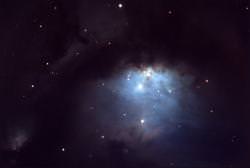 Greetings, fellow SkyWatchers! We start the week with a celestial scenery alert just before dawn… Look for the Moon, Antares, Jupiter and Mars! The days ahead are filled with alternative catalog studies and meteor showers. So be sure to look skyward, because…
Greetings, fellow SkyWatchers! We start the week with a celestial scenery alert just before dawn… Look for the Moon, Antares, Jupiter and Mars! The days ahead are filled with alternative catalog studies and meteor showers. So be sure to look skyward, because…
Here’s what’s up!
Continue reading “What’s Up this Week: January 15 – January 21, 2007”
What’s Up This Week – May 22 – May 28, 2006
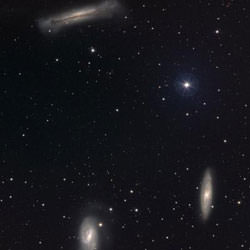
The Leo Triplet. Image credit: REU Program/NOAO/AURA/NSF. Click to enlarge
Greeting fellow SkyWatchers! This week will be a great time to go galaxy hunting and seeking out all the bright a beautiful deep space objects that signal the end of Spring and the beginning of Summer. So get out your binoculars and telescopes and get ready to rock, because…
Here’s what’s up!
Monday, May 22, 2006 – Tonight would be a great opportunity to do some binocular hunting. Starting at Regulus, see how many faint galaxies you can spot about a fist width due east. Among the brightest will be M105, M95 and M96. Another fist width east will take you just below Theta Leonis for the must easier M65 and M66.
Now return to Regulus. About a thumb’s length to the west-southwest you will spot dim R Leonis – a Mira-type variable. Discovered in 1782 by J.A. Koch, this awesome star moves from magnitude 4.4 to 11.0 magnitude is less than a year. As one of the earliest discovered, you will find it a ruby red color that goes to deep purple during its cycle. A true gem!
Tuesday, May 23 – Tonight we move on to small telescope studies as we begin at Beta Leonis (Denebola) and look about a hand span west-southwest for Epsilon Virginis (Vindemiatrix). Almost directly between them is the most heavily galaxy populated portion of the sky for a small scope!
About three finger-widths west of Epsilon, you will find M59 and M60 with M58 just a breath further west. At low power, shifting northwest one field of view will bring you to M89 and then go northeast another field for M90. Return to M89 and go less than two fields away for M87. Two fields north will bring you to M88, while one east will help you find M91.
If you get lost, don’t worry. One of the most beautiful experiences in Virgo is to simply enjoy all you can see!
Wednesday, May 24 – Be sure to check the sky this morning as brilliant Venus and the Moon have a scenic encounter.
Tonight we’ll head into larger scope territory as we explore the area around the galactic pole and star 31 Comae.
As a known member of Melotte 111, 31 Comae is an eclipsing variable star with a faint companion. Begin by centering on 31, and move south a little more than two degrees for a large, 9.2 magnitude spiral galaxy – NGC 4725. Encircled by a halo, this study contains a luminous oval nucleus. A little more than 3 degrees west-northwest will bring you to the spectacular NGC 4565. This large, slender, edge-on presentation is an easy 9.6 magnitude which shows a dark dust lane.
Now shift NGC 4565 a little more than a degree east to view the small, 9.9 magnitude elliptical galaxy – NGC 4494. Return to NGC 4565 and move two degrees north for NGC 4559. This large, 9.9 magnitude, tilted spiral will show a multi-armed structure and some patchiness to its detail. To complete the tour, four degrees east again and you’ll find yourself back at 31 Comae!
Thursday, May 25 – Has Gemini gained another twin? No. It’s just Mars south of Pollux.
Tonight, let’s try a series of challenges designed to intrigue all SkyWatchers. For visual observers, your goal is just east of Saturn. Allow your eyes plenty of time to dark adapt and seek out a large hazy patch of barely visible stars. Congratulations! You’ve just spotted M44 and seen the light – light that left the cluster in the year 1480!
For binoculars, look a fist width west of bright Spica and you’ll pick up M104. Its light came from 400 million years ago.
For the large telescope, your challenge lies five and a half degrees south of Beta Virginis and one half degree west. Classified as Arp 248, and more commonly known as “Wild’s Triplet,” these three very small interacting galaxies are a real treat! Best observed using higher magnifications, use wide aversion and try to keep the star just north of the trio at the edge of the field to cut glare.
Best of luck!
Friday, May 26 – This evening we’re going to have a look at two of the finest globular clusters for the northern hemisphere. Entering the middle third of the sky to the northeast is everyone’s favorite and champion of the overhead sky – the Great Hercules Cluster – M13. Just grazing the sky’s middle third to the south-southeast is the equally spectacular M5 in Serpens.
At magnitude 5.8, M5 is only slightly brighter cumulatively than M13 and is also just slightly larger. With good reason…It’s 600 light-years closer.
Now let’s go locate each of them. M13 is easily found just one-third the way between Eta and Zeta Herculis along the western flank of the Keystone. To locate M5, you’ll find it slightly northeast of 5 Serpens.
Which gives the better view? Well leave the decision to you!
Saturday, May 27 – Tonight is New Moon Saturday and many observers will be packing their scopes up and heading for dark skies. Many will enjoy the camaraderie of other amateurs – plus opportunities to look through different equipment and discover entirely new night sky favorites. If you’re on your own, keep this in mind: the best locations for observing will be far from city lights, at higher altitudes, and hampered by little foliage – especially to the south where studies sometimes only barely manage to clear the trees before they’re gone again. Since most star parties are held at well-selected locations, a lot of the work has already been done for you!
For observers below 40 degrees north latitude, one study will be on everyone’s list tonight – the incomparable Omega Centauri! To see it, you simply must have a clear view of the horizon to the south and begin looking for it well south of Spica as soon as it starts to get reasonably dark out. Don’t expect much of a view from the northern hemisphere. Omega may look no better than a large unresolved misty glow. But you just have to look anyway!
Even before that peek at Omega, Jupiter will dominate the sky to the south – so arrive early and set up just after sunset. Within a half hour you will see the planet culminating south. Once you’ve had that first look at Jupiter, you might want to look west toward Gemini and say goodbye to Mars and Saturn. If the seeing is really good, you will probably want to spend some quality time with Jupiter throughout the evening. One thing to watch for, the strikingly high contrast and well-defined shadow of a Galilean as it transits Jupiter’s atmosphere.
After Omega Centauri and the planets, the sky’s the limit!
Sunday, May 28 – On this day in 1959, the first primates made it to space. Abel (a rhesus monkey) and Baker (a squirrel monkey) lifted off in the nose cone of an Army Jupiter missile and were carried aloft into sub-orbital flight. Recovered unharmed, Abel died just three days later from anesthesia during an electrode removal, but Baker lived on to the ripe old age of 27.
Tonight let’s monkey around with the stars as we climb into the canopy of the heavens towards 7.7 magnitude M101!
The sprawling nature of this face-on spiral means that the light of an 8th magnitude star has to be spread very thin to cover all that celestial terrain. Its 10th magnitude core region allowed Pierre M?chain to view it on March 27, 1781. This inclusion was the last published entry in Charles Messier’s catalog. Meanwhile William Parsons (Lord Rosse), described M101 as “Large, spiral, faintish; several arms and knots. 14′ diameter at least.” – a description comparable to what is seen through the largest backyard telescopes used today.
At a distance of 27 million light-years, the true size of M101 is extraordinary – some 170,000 light-years in diameter. Its total luminosity is equivalent to over 30 billion suns. Even as large as this galaxy is, it merely approaches the size of the Milky Way!
May all your journeys be at light speed… ~Tammy Plotner with Jeff Barbour.
